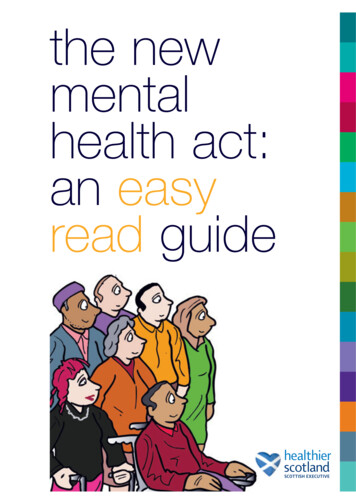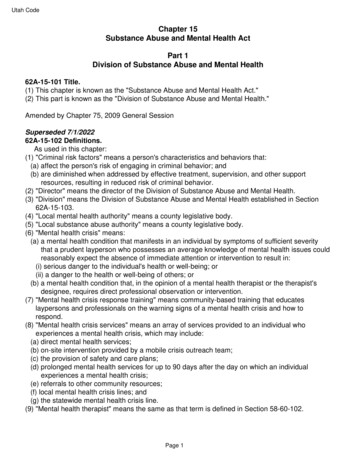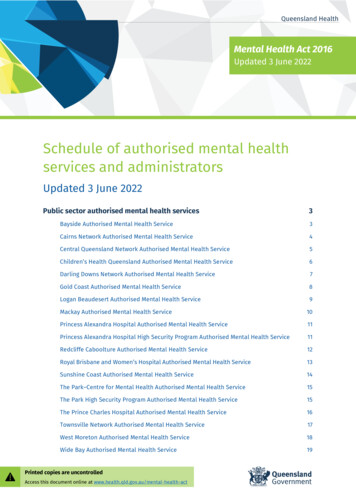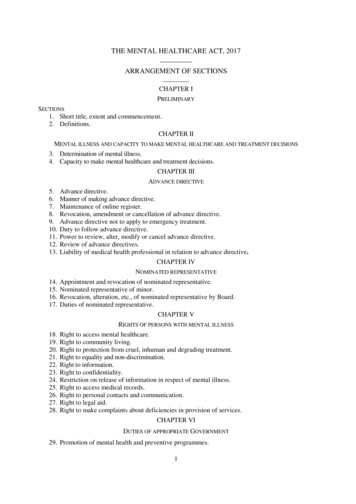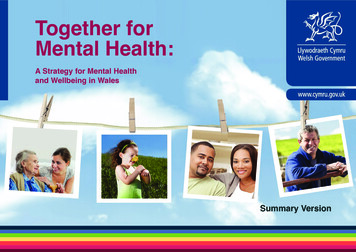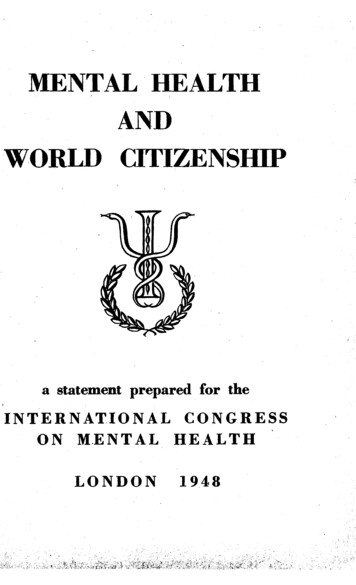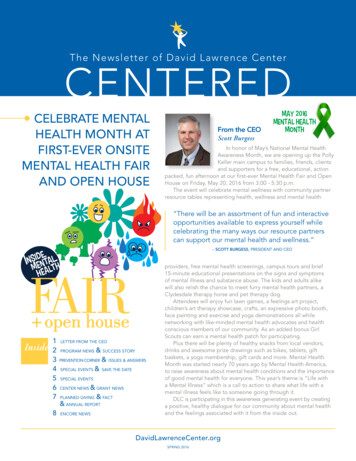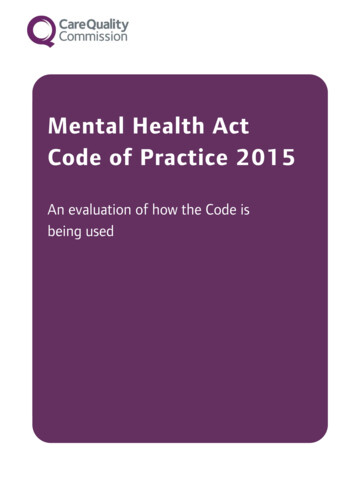
Transcription
0 Mental Health ActCode of Practice 2015An evaluation of how the Code isbeing used
ContentsKey findings and recommendations . 3Introduction . 5How is the Code of Practice being used? . 8Enablers and barriers to good practice .13Conclusion .16Appendix: Section 140 .17References .182
Key findings and recommendations The Mental Health Act (MHA) Code of Practice is still not being used as it was intended tobe, with variation in providers’ understanding of the Code and how it should be applied. We looked at three key areas for more insight into the issues. These included understandingand application of the guiding principles, engagement and involvement of patients, andlocal area working and section 140. We found that:o Providers lacked understanding about how to promote, apply and report on the guidingprinciples in the Code of Practice.o Providers did not support staff well enough to enable them to have meaningful andproductive conversations with patients so that they can better understand patients’goals and how patients can take ownership of their recovery. Independent MentalHealth Advocates (IMHA) offer an additional safeguard and support for patients, butour review of MHA reports shows ongoing difficulties with providing IMHA support.o Local areas, including commissioners, local authorities, police and providers, shouldwork together better to make sure that people receive the right care acrossorganisations, including making sure that people in need of urgent care have timelyaccess to a bed that is close to home, in line with the expectation of section 140 of theMHA.Feedback from stakeholders and experts throughout our review also identified a number ofoverarching themes that were common across our three key areas of focus.o Awareness of the Code of Practice and/or the easy read version remains low amongpatients, families and carers. Like providers, even when they knew about the Code, theyfound it difficult to navigate or use in a meaningful way.o The current format of the Code is not easy for staff and professionals to use. Over theyears the Code has grown from 135 pages to over 450 pages. While the 2015 version isavailable as an electronic file, it is not fully accessible and does not include easynavigation or links to other relevant care standards.o The quality, content and focus of training for staff on the Code of Practice varied. Whilewe saw some examples of good practice, the size and breadth of the Code was achallenge, with some providers still not having updated their training to reflect the2015 Code.o The quality of governance and oversight of the MHA and the Code varied. While weaccept local arrangements can vary, these need to make sure that the MHA and Codeare used effectively, and that changes are driven forward to improve the experience ofdetained patients.RecommendationsBased on our findings, we recommend, as part of their response to the independent review ofthe MHA, the Department of Health and Social Care (DHSC) takes a lead in: Developing standardised resources, support and training for patients, carers and staffso that they understand how the Code applies to individuals, practice, services and localpartnerships.3
Promoting the use of the guiding principles to improve practice and enablemeaningful engagement with families and carers. The guiding principles need to berecognised as a support tool for human-rights based approaches by staff and services. Making sure that the Code of Practice gives clear and consistent guidance onproviders’ governance arrangements. This includes guidance on ensuring that how theMHA and Code are being applied is reported on at senior leadership level. Improving the usability of and access to the Code of Practice, taking into account theway the Code is intended to be used in practical situations between patients and their careteam. This should include considering how to make the Code digitally accessible to patients,carers and clinicians. For example, a search function with accessible links to other relevantguidance would enable professionals to find relevant guidance quickly to support their dayto-day work.4
IntroductionAs the independent regulator of health and social care services and the monitoring body for theMental Health Act (MHA), CQC is responsible for assessing the care, treatment and supportoffered to people subject to the MHA in services across England. When we review how servicesare using the MHA, and what this means for people's care and treatment, we compare what wefind with available standards, legislation and guidance. In this way, we know what good lookslike and can identify and report on areas that require improvement.Following a request from the Department of Health and Social Care (DHSC), we have workedwith stakeholders to evaluate how well the MHA Code of Practice (‘the Code’) is being usedacross mental health services since it was updated in 2015. We looked for the enablers andbarriers that services have found in using the guidance and what impact this has had onpeople’s experience of detention, care and treatment. The request to evaluate the Codefollowed a recommendation in the Five Year Forward View for Mental Health (recommendation51) and a commitment made by DHSC in the Equality Impact Assessment prepared for therevised Code (2015).We carried out this evaluation at the same time that the MHA independent review was underway. The MHA review report was published in December 2018, with the government responseexpected later in 2019.1 Any changes made to either legislation, policy or practice will require anew Code of Practice. This report highlights the key areas of improvement and learning fromthe current Code. These must all be addressed in future revisions if the Code is to provide astrong safeguard for patients, families, carers and support professionals and services.Background to the Code of PracticeThe MHA Code of Practice was first created in 1993 to help professionals and others working inservices to interpret the MHA as it applies to decision-making in day-to-day practice, and toprovide safeguards for involving and protecting people in mental health services. The Codeincludes guiding principles that should always be considered when making decisions in care,support or treatment. The government expects the Code’s principles and guidance to be used inall services that detain patients. One of the purposes of the Code is to help local services tosupport the empowerment and involvement of patients and carers, and to make sure thatsafeguards are in place to support and protect the dignity and respect of people.5
History of the Code of Practice 1993 – 135 pages: covered assessment, admission in hospital, guardianship,treatment and care in hospital, leaving hospital and standards for people with alearning disability and children and young people under the age of 18. 1999 – 115 pages: updated to include guiding principles and reflect changes in lawand policy. 2008 – 394 pages: new guidance added relating to the Mental Capacity Act, HumanRights Act added, as well as developments in law, policy and practice. 2015 – 459 pages: new sections for the role of CQC, complaints and commissioning,plus additional guidance to reflect and embed developments in areas includingrestrictive interventions, seclusion, use of police powers and use of communitytreatment orders.DHSC last reviewed the Code in 2015. Many stakeholders were involved in this review andidentified the changes needed to make sure that guidance in the Code would be up to datewith current law and policy, so that it offered patients stronger safeguards. DHSC alsocommitted to making the document as accessible as possible for people affected by the MHA.National reports, including the NHS Five Year Forward View for Mental Health (2016) and ourreport Mental Health Act – The rise in the use of the MHA to detain people in England (2018),have shown that the number of people detained under the MHA has risen across England inrecent years. This means that the use of the MHA to detain people in inpatient mental healthservices is much more common than when the Code was first created. As a result, it is moreimportant than ever to make sure that the Code is clear, accessible and supports the legalsafeguards that protect people’s human rights and autonomy.What we didThe 467-page Code covers many aspects of the care pathway for people subject to differenttypes of detention under the MHA, as well as informal admissions and treatment in thecommunity. It uses the legal framework of the MHA to provide guidance on applying the MHAat various stages of the patient’s journey, from assessment and admission to hospital, throughto leaving hospital and aftercare. We worked with stakeholders to identify three key areas thatwould provide a good insight into how well providers are applying the Code in practice. Thequestions we sought to answer were:1. Have the revised guiding principles had an impact in practice?2. Have providers taken action to improve the way they are empowering and involvingpatients in their care?3. Did the new guidance in the Code have an impact on the way local services worktogether when people need urgent admission to a mental health bed?We looked at data from our annual programme of work with patients and providers. Thisincluded our visits to services and interviews with patients across NHS and independent mental6
healthcare providers registered to assess and treat people subject to the MHA in their inpatientservices.a We also used information from: Qualitative sampling of over 400 issues raised during MHA monitoring visits about the useof the guiding principles between July 2012 to March 2018. A literature review by the Collaborating Centre for Values-based Practice in Health andSocial Care in Oxford of published materials referencing the history and use of the guidingprinciples. The literature review also included telephone and face-to-face meetings withexpert witnesses including people who use services, clinicians, regulators, lawyers andclinical educators. Engagement with people with past or current lived experience at our Service User ReferencePanel. A workshop with commissioners, providers, police, social workers and local authority staff. A provider-level engagement webinar with professionals working with the current Code. Engagement with expert stakeholders from our MHA External Advisory group.bFindings have been corroborated and, in some cases, supplemented with expert input fromstakeholders involved in the review.The Health and Social Care Act requires healthcare providers to register for this separately to their other services.We also have several acute service providers registered for the less frequent situation of a detained patient beingcared for in their service while receiving medical treatment. We do not carry out regular monitoring visits to theseservices, although would look at their MHA systems and processes during an inspection or in response to anyconcerns.b This includes representatives from NHS England, Department of Health and Social Care, service user networks,Royal College of Psychiatrists and mental health provider representatives.a7
How is the Code of Practice being used?Through our review, we have seen services using and applying the Code of Practice in differentways. For example, we have heard positive examples of activities to raise awareness andunderstanding of the Code, such as updating local policies and procedures, or delivering localtraining packages. But we have also found that understanding of the Code varies, even withinservices. This includes variation in the level of understanding about how the Code should beapplied and the perceived benefit of doing so.1. Have the revised guiding principles had an impact in practice?Overall, we found that the impact of the guiding principles was limited. In general, providerslacked understanding about how to promote, apply and report on the guiding principles.The guiding principles were first introduced into the Code of Practice in 1999. Their intendedpurpose is to guide providers as to how they should apply the MHA to individuals in specificcircumstances, what care options need to be considered and how to make sure that theyconsider patients’ individual values, wishes and views. Following the revisions made in 2015,the current guiding principles are: Least restrictive option andmaximising independence Empowerment and involvement Respect and dignity Purpose and effectiveness Efficiency and equity.When the new Code was published inApril 2015, providers were asked tomake sure that they were applying thenew Code and guiding principles byOctober 2015.Brief Workbook to Support Implementation of theMental Health Act 2007, Care Services ImprovementPartnership and National Institute for Mental Healthin England (2009)We found some good examples of providersapplying the guiding principles for the benefit ofindividuals. This included local services that hadtaken steps to support staff in applying theprinciples. These services saw the principles as a useful tool for achieving human-rights basedapproaches and providing a helpful overview for patients and carers to understand howdecisions were made.However, our reports highlighted particular areas of concern where we found that the guidingprinciples were not being routinely implemented to inform practice in the way they should.These included: Least restrictive principle. MHA reviewers were most likely to request services to takeaction to improve practice relating to the “least restrictive” principle. This was often inconnection with the use of blanket restrictions, routine searches or high observation levelsto manage risk.8
Respect and dignity, and purpose and effectiveness. We were most likely to requireservices to report how they are applying the guiding principles of “respect and dignity” or“purpose and effectiveness” when we found problems with the physical, social andtherapeutic environment of the ward. This included the presence of dormitories, as well as afailure to make sure that they were complying with guidance on eliminating mixed sexaccommodation. This was also the case when we saw poor care planning (including accessto information or advocacy), and problems with staffing (including the numbers of skilledstaff available to support patients). Empowerment and involvement. We asked providers to look at how they are applying theMHA and Code when we heard concerns about the way people felt supported to beinvolved in their care, raise concerns about the service they are in or told us that they didnot feel listened to. We also asked them to consider how they can improve care forindividual patients through the “empowerment and involvement” guiding principle.Providers’ responses to our concerns about the way principles are being applied often includedetails about how they plan to address these issues. This includes, for example, discussions inward meetings, carrying out local audits, training or updates to policies and procedures toimprove adoption of the principles.Our overall conclusion was that many providers lack understanding about how to promote,apply and report on the guiding principles. We passed these findings, and our conclusion,directly on to the independent MHA review in 2018. The review has since maderecommendations to include principles on the face of the MHA – making them a statutoryrequirement to be applied – and to include reference to them in the statutory paperwork usedwhen detaining patients.While we wait for any national changes, we can report that during our evaluation we saw someexamples of providers applying the guiding principles well. For example, this included localservices who had taken steps to support staff in applying the principles, seeing them as a usefultool for achieving human-rights based approaches and providing a helpful overview for patientsand carers to understand how decisions have been made.2. Have providers taken action to improve the way they are empowering andinvolving patients?People who are subject to the MHA are in a vulnerable position because it allows for the forcedtreatment of individuals who do not agree, or are unable to agree, to their treatment plan. Theprinciple of “empowerment and involvement” in the Code of Practice is intended to providesafeguards for people to make sure that they are encouraged, supported and involved in theircare as fully as possible. The Code provides specific guidance on how patients subject to theMHA can be involved in decision-making. This guidance should be considered against thegeneral expectations that apply for all people undergoing medical care and treatment, such asthose set out in the Mental Capacity Act and by the National Institute of Clinical Excellence(NICE).Through our review, we have not found evidence that the Code has prompted a substantialchange in the way services are empowering and involving people in their care. As highlighted inour report Monitoring the Mental Health Act 2017/18, we are still receiving frequentcomplaints, through our MHA complaints service, from people who do not feel appropriatelyinvolved in or informed about their care.9
We looked at a sample of 40 reports where MHA reviewers had raised concerns with providersabout the involvement of patients, carers and relatives in decisions about their care andtreatment. In around half of these, providers told us they would carry out audits, reviews andseek feedback from patients and staff to address the issue of lack of involvement.However, out of the 40 cases in our sample, only 10 providers had identified the need forfurther staff training and development. This is essential for staff to give them the skills andknowledge they need to be able to engage effectively with patients and to involve them indecisions about their care and treatment. Providers need to consider how they support staff tohave meaningful and productive conversations with patients, so that they better understandindividual patient’s goals and how patients can use their qualities and strengths to takeownership of their recovery.Learning from the Welsh MHA Code of PracticeThe guidance in the Welsh MHA Code of Practice includes information on the type of trainingthat should be provided, as well as learning outcomes and how evidence-based best practiceshould underpin all learning.2 The guidance set out expectations that, as well as receivingtraining on the Welsh Code, professionals working with detained patients should receivetraining on communication and a range of specialist-related skills and topics. These includeunderstanding the significance of developing a supportive relationship with patients, treatingpeople with dignity, being culturally sensitive and respecting individuals’ diversity, and theimportance of providing a safe and positive environment for patients.The Code sets out the training areas as including the core elements that all service providersand commissioners should consider as part of their training strategy, training about specificpatient groups, learning for specific roles and broader training for commissioners and managers.Independent Mental Health Advocates (IMHA) offer an additional safeguard and support forpatients to make sure that they are meaningfully involved in their care. Introduced in 2007 aspart of amendments to the MHA, IMHAs are trained specifically to work with detained patientsto help them to take part in decision-making, and to support them to express and communicatetheir views. However, our review of MHA reports shows ongoing difficulties with providingIMHA support. This includes ward staff not always knowing when a referral should be made, alack of knowledge about the differences between the various advocacy services available and areduction in IMHA services nationally.10
3. Did the new guidance in the Code have an impact on the way local serviceswork together when people need urgent admission to a mental health bed?Section 140 of the MHA places a duty on commissioners to notify local authorities in theirareas of arrangements for: admitting people in need of urgent care people who need appropriate accommodation or facilities designed for children andyoung people under the age of 18.3Although this duty has been part of the MHA since 1983, the 2015 Code was the first toidentify how this should be managed locally. The new guidance in the Code, “Commissioningand section 140”, proposed that local authorities, providers, NHS commissioners, police forcesand ambulance services should make sure that a clear joint policy is in place for the safe andappropriate admission of people in their local area. This should be agreed at board level andeach party should appoint a named senior lead.4As part of our review, we looked at whether the new advice and guidance led to improved jointagency responses for the urgent access and admission of patients. We worked with NHSEngland and others to hold a workshop with commissioners, local authorities, police, ambulanceservices and providers to discuss what local arrangements exist to support their implementationof section 140. Participants told us that there continued to be a lack of understanding on theroles and responsibilities of each organisation in implementing section 140. This included howthis differs from bed management and agreement on what the definitions in section 140 meanand how they should be applied. For example, the term “special urgency” may be applied toboth people assessed as needing detention under the MHA, or people not meeting criteria fordetention but urgently needing a mental health bed. Attendees reported that only two clinicalcommissioning groups in the country were known to have a section 140 policy in place, which isrecommended as good practice in the Code. The fact that we found limited evidence of section140 policies suggests that clinical commissioning groups are not aware of the guidance andsupport that the Code offers on section 140.Greater awareness, senior oversight and monitoring of information relating to section 140processes could help patients, medical staff and approved mental health professionals to findmental health beds, avoid delays when people require admission to specialist settings and helpinform the commissioning needs for alternative services, including crisis houses and communitysupport services. However, we found that the revised guidance has not had an impact onmaking sure that there are locally agreed joint protocols in place to support the implementationof section 140.Our evaluation of how well section 140 is being implemented suggests that commissioners arenot doing enough to make sure that they are meeting their statutory responsibilities andapplying the supporting guidance in the Code. If the legal obligation under section 140 is notdischarged as intended, approved mental health professionals are often left in a difficultsituation when they have assessed someone as requiring detention under the MHA but areunable to find a bed. In some cases, a suitable bed can only be located out of area, miles awayfrom a person’s home and family. Additionally, people who are arrested under criminal law arestaying in police cells for too long, often unlawfully, after it has been established that theyneed to be admitted to hospital following an assessment under the MHA.The independent review recognised that section 140 needs to be applied more consistently andeffectively. To achieve this, the independent review made a number of recommendations,including that NHS England, DHSC and CQC should work with CCGs, local authorities, the11
AMHP Leads Network and providers to understand how section 140 is being used currently.The independent review has also recommended that clear joint guidance is issued to supportcommissioners to discharge their statutory duties under section 140.The way services are commissioned is evolving. There is a trend towards commissioning overlarger areas and there are examples of CCGs and local authorities working together to supportthe integration of services across health and social care. With changes being made to the waycommissioning is delivered in practice and with organisations working more collaboratively,there is an opportunity to provide further practical tools and guidance to commissioners tosupport them to implement section 140 and the associated Code guidance in Chapter 14.12
Enablers and barriers to good practiceFeedback from stakeholders and experts identified a number of overarching themes that werecommon across our three key areas of focus. These included: awareness and understanding of the Code quality of staff training on the Code increasing usability for staff and professionals clear and consistent governance, monitoring and reporting.This section looks in more detail at these themes and identifies some of the barriers andenablers to good practice.Improving awareness and understanding of the CodeDuring the last revision of the Code, DHSC highlighted that there were challenges aroundawareness and accessibility of the Code for providers, patients and carers (see section‘Increasing usability’).5 Our evaluation found that this continues to be one of the mostsignificant barriers to implementing the Code’s guidance for both statutory requirements andadvice on best practice.In particular, we heard that there was very low awareness of the Code of Practice and/or theeasy-read version among patients, families and carers. Even when they knew about the Code,they found it difficult to navigate or use in a meaningful way in its current format (see section‘Increasing usability’). Patients who understood the Code, felt able to participate more indecision-making, to consider challenging services or to request additional support. However, formany people the way the Code is written acts as a barrier to understanding “what good carelooks like” that people should expect to receive. This is a particular problem at admission whenthey receive a lot of information, often when in distress.Quality of staff training on the CodeThe quality, content and focus of training for staff on the Code of Practice varied nationally.We saw some excellent examples of good practice where providers had tailored training on theCode for different teams. But the size and breadth of the Code was a challenge for others, withsome providers still not having updated training to reflect the 2015 Code, or considering howthe MHA and Code could have implications for all clinical training.Training and support are essential for all staff involved in caring for detained patients. Thisenables them to work innovatively and challenge practice where it falls below expectedstandards of care. However, registered nurses and healthcare workers are often offereddifferent types of training. In some cases, healthcare workers are not offered training on theMHA and the Code, even though they spend a larger proportion of their time with patients.Participants in our provider webinar told us about their local approaches to MHA training.These included multi-agency training sessions held with the police on subjects such as section136. We also heard examples of MHA awareness training for support workers and healthcareassistants caring for detained patients, which recognised that these staff would benefit fromtraining as well as qualified staff. Some participants also told us that they included recurringthemes and learning from MHA monitoring visits in their MHA training.13
However, we also heard concerns about the varying quality of training. For example, there wereconcerns that training on the Code was given only alongside basic training about the MHA,allowing little time to explore how to apply or use of the Code in practice, or how the guidingprinciples can be used to inform human-rights based decision making or clinical approaches.Participants told us that they would welcome a national training plan, which would help tomake sure that there was consistency of training and that there were resources for local trainingneeds. This would be similar to the Welsh MHA Code of Practice 2016 that sets out whatshould be covered in training and what level of training should be delivered to differentprofessionals working with the Code.6Increasing usability for staff and professionalsSince the Code was first created in 1993, there has been an expectation that a hard copy of thebook would be available on wards, available on wards, to both patients and clinicians. Over theyears, the Code has grown from 135 pages to over 450 pages. The 2015 Code is available as anelectronic file but is not fully accessible, and does not include easy navigation or links to otherrelevant care standards for best practice and legal frameworks, for example, NICE guidance orthe Mental Capacity Act and associated Code of Practice.We heard that the current format of the Code is not easy for staff and professionals to use tosupport clinical or professional decision-making and practice. Doctors, approved clinicians,managers and staff of provider services are more likely to rely on support staff (usually MHAadministrators who are appointed to m
2008 - 394 pages: new guidance added relating to the Mental Capacity Act, Human Rights Act added, as well as developments in law, policy and practice. 2015 - 459 pages: new sections for the role of CQC, complaints and commissioning, plus additional guidance to reflect and embed developments in areas including
